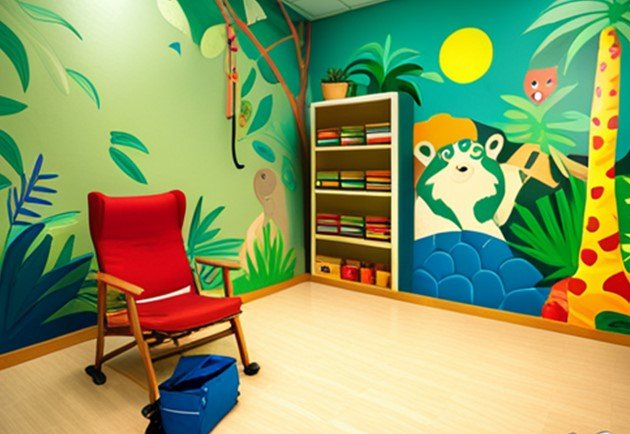When it comes to designing attractive and educational environment for young children, the wall painting plays an important role for kindergarten and preschool wall pictures. The right subjects not only make the space visually attractive, but also stimulate learning and creativity. Let’s find out some exciting themes for wall painting that can turn any class to a lively, interactive learning environment.
Table of Contents
Wall Painting For Kindergarten
1. Jungle Theme
A jungle theme on your preschool wall painting idea offers kids a glimpse into an adventurous jungle world in one go. Wildlife Discovery can be a fun theme which is often decorated with lush trees, exotic animals, and vibrant colors that can capture the young minds. Jungles are a really nice theme where children are encouraged to explore and get creative, but also learn about animals and nature in an immersive and cool way. The Jungle Theme: An Overview One of the main things that makes the jungle theme interesting is how imaginative it can be. The lively backdrop lends itself to conversation about wildlife and habitats, and environmental conservation, making it ideal for educational and emotional development.
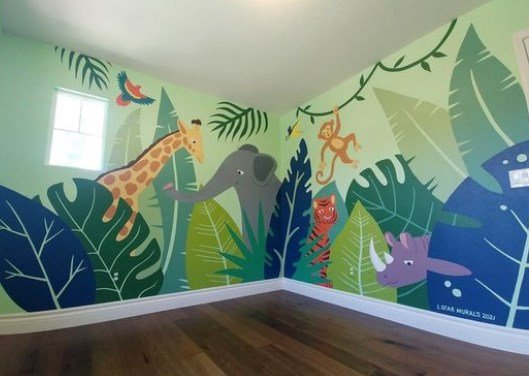
Use several shades of green and textured leaves to create a dense jungle background for a sense of immersion in space. Use colorful animal silhouettes — parrots, tigers, and monkeys — that pop against a green backdrop. Incorporate interactive elements such as animal sounds or textures (e.g., faux fur for animals) that children can touch and play with. Create a nook of the room that resembles a treehouse or jungle hut (think like tarzan), offering a snuggly reading or meditative place.
2. Pet Animals Theme
There are also wall paint ideas for kindergarten with the theme of pet animals. Text tentang animals friendly animals such as dogs, cats, rabbits this theme gives warmth and comfort It helps to relate it with their own pets and foster a sense of connection and empathy while dreaming about future pets too. The bird pets theme is useful in teaching children an engaging way about responsibility and how to care for animals. It also helps with social-emotional learning by creating a home away from home.

Add large, smiling portraits of popular pets such as dogs, cats and rabbits to make the room welcoming. Designate an area with visuals of pet care activities like feeding, grooming, and playing. Put up boards for children to stick up photos of their own pets or drawings of their favorite animals. Introduce pet-friendly furniture such as doghouse- or cat bed-inspired seating or storage units. Include simple educational materials about pet care and animal behavior, built in the wall design.
3. Traffic Theme
A traffic theme is an exciting alternative to preschool wall painting, including elements such as traffic lights, road signals and vehicles. This subject learns in a blind stimulating experience about road safety and transport. Colorful and dynamic design attract children’s attention and make the learning process fun. Traffic subjects are important to teach the importance of basic road safety rules and traffic rules. It blindly provides practical lessons in an attractive manner, which helps children understand their role as pedestrians and future drivers in a safe environment.

Paint bright and colorful traffic signals and road signs to make the subject academic and visually attractive. Include the murals of various vehicles such as cars, buses and bicycles, with each favorable face or cartoon features. Create a large, interactive road map on the floor or wall where children can move toy vehicles and learn about traffic rules. Paint traffic lights with moving parts or use lights to display how traffic signals work.
4. Aquarium Theme
An aquarium theme brings the miracles of the underwater world to life through vibrant wall paintings for kindergarten. Characteristics of colored fish, sea creatures and coral reefs, this subject fascinates children with the secrets of the sea. It creates an enchanting and educational place where children can learn about marine life. Aquarium theme supports environmental awareness and appreciation of biodiversity. By introducing children to various marine species and their houses, it promotes curiosity and respect for the ocean and its creatures.
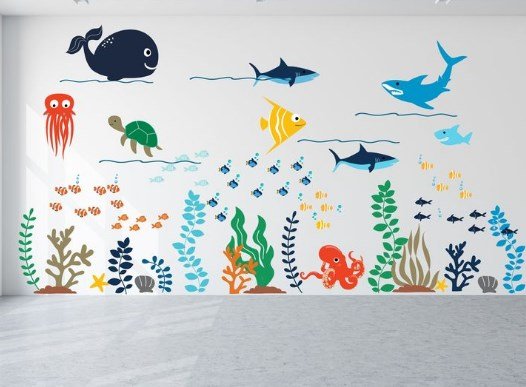
To create a calm environment, give employment to soothing blues and greens, which reflects the atmosphere of the ocean. Use safe, non -toxic materials and paints that are durable and suitable for a child -friendly environment. To maintain the beauty and hygiene of the subject, select the option of washedable or easily cleaned surfaces. Add accurate details about marine life to educate children while maintaining an attractive visual appeal. Include elements that encourage exploration and learning, such as simple sports or puzzles related to marine themes.
5. Study Base Theme
The study base theme is designed to create a favorable learning environment with wall painting for kindergarten, including elements such as books, pencils, and educational icons. The subject is both inspiring and practical, encouraging children to embrace their studies in a fun and inspirational setting. The importance of the study basis lies in its ability to strengthen the value of education. Around children with images related to learning, it helps to create a positive attitude towards school and educational activities from an early age.
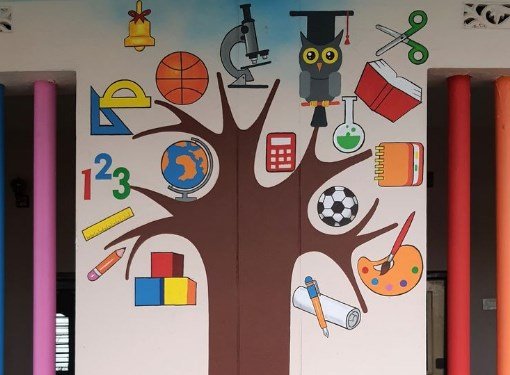
Paint walls with images of open books, learning tools and educational icons such as apples and pencils. Include inspirational quotes about learning and education to create a positive atmosphere. Add boards or chalkboard where children can engage in drawing or writing while complementing the theme. Nomine areas with the themed Decor related to different subjects, such as “mathematics corner” with numbers and shapes. Make a mural image that incorporates elements of different subjects, such as world map or science-theme murals.
6. Space Theme
A space theme provides an out-off-the-world experience through a preschool wall painting characterized by planets, stars and astronauts. This topic ignites children’s imagination and curiosity about the universe, which is exciting and memorable about space. Space the subject benefits children by expanding its understanding of astronomy and space exploration. It provides a fickle educational setting yet where children can learn about solar system and space travel, can cause interest in science and search.

Paint a roof or upper wall area with the sky of a wire with a wire, complete with shining stars and constellations. Create a wall or chain of paintings characterized by colored planets, including the Sun and Moon in a playful, child -friendly style. To make the theme interactive and exciting, include astronaut cutouts or life-size figures in the space suit. Design a corner of the room to look like a rocket launch site with interactive elements such as a vomiting clock. Add a small science station with space-themed educational materials, such as a solar system or model of space exploration equipment.
7. Farm Theme
A form theme in wall painting for kindergarten introduces children to the attraction of rural life with images of children, crops and farm machinery. This subject creates a comfortable and educational environment that teaches children in an attractive way about agriculture and animal husbandry. The subject of the farm is important to provide knowledge about where the food comes from and the fields have a role in our daily life. It helps children to connect with nature and helps to understand the importance of farming and agriculture through interactive and colorful scenes.

Lively mural paintings characterized by barn to create a warm and invited atmosphere, characteristic of classic farm scenes with animals and crops. Use large, favorable cutouts of farm animals such as cows, pigs and chickens to add dimensions and fun. Create a corner with a view of farm equipment such as tractor and plow, with possibly interactive features. To teach children 3D images of feature paint or farm vegetables and fruits to teach children where their food comes from. Install a mini farmard area with educational toys or activities related to farming and agriculture. To create a comfortable, natural environment, employ warm, earthen tones that mimic the spirit of a real farm.
8. Seasons Theme
One season the theme brings the changing season and natural cycles to your preschool wall painting. Characterizing the imagination related to spring, heat, decline and winter, the subject helps children to pass time and understand the effects of seasonal changes. The importance of the season theme lies in its educational value. It teaches children about various seasons, weather patterns, and how these changes affect the environment. This subject promotes a deep praise for nature and cyclical rhythm of the world around them. Raise the space of your room with beautiful flower painting on the canvas, perfect to add a touch of nature. These artifacts bring the beauty of flowers to your living space.
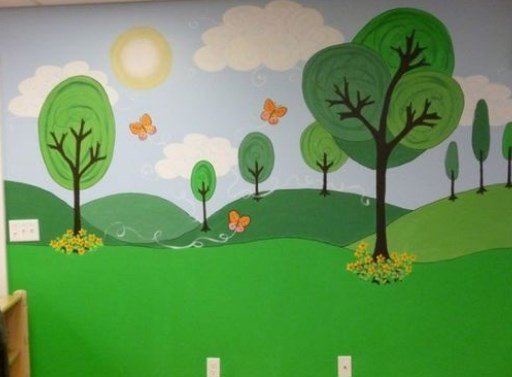
To represent each season, paint different sections of the room, with different characteristics such as spring flowers, heat sun, autumn leaves and winter ice. Create a board or wall with movable elements such as seasonal weather icons, clothes and activities to interact with children. Use leaves for winter to fall to fall to fall to fall to the snowflakes, flowers for spring, and seasonal touch throughout the year. Install a small area with simple weather -related activities or equipment to teach children about weather patterns and seasonal changes.
9. Community Helpers Theme
Community assistant subjects display various businesses such as doctors, firefighters and police officers through lively wall paintings for kindergarten. This topic helps children to learn about important roles that members of different communities play in keeping everyone safe and healthy. Community auxiliary subjects are beneficial for various businesses to promote a sense of respect and understanding. It encourages children to make positive contribution to their communities, to promote social awareness and sympathy.
Painted walls with scenes featuring various community assistants such as firefighters, doctors and police officers in action. Create a dress-up area with costumes representing various community assistants for roll-playing and imagonative plays. Use boards or walls to demonstrate various businesses with interactive elements such as touch-end-panel or simple quiz. Feature profiles or “heroes” with funny facts about spotlights on various community assistants, their roles and contributions. Design maps or diagrams show that various community accessories work within the community to portray their roles.
10. Healthy Living Theme
The theme of a healthy way of living in prescriptal wall paintings involves encouraging well-being through illustrations of healthy food, physical exercise and hygiene. The theme provides an environment that stimulates children to embrace healthy habits and learn the need for a balanced living. The subject of healthy stay benefits children by strengthening positive behavior and health education. It helps to establish a lifetime habits of healthy food, regular exercise and personal hygiene, which contributes to an active approach to overall welfare and health.
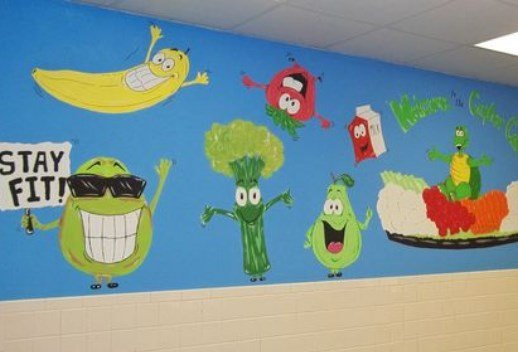
Failure paintings with colored fruits, vegetables and healthy food to promote good food habits. Create an interactive exercise area with images and simple exercises for children, such as jack or stretch jumping. Design hygiene practices such as handwashing and brushing teeth with visual and educational material about teeth. Set a chart or poster for a daily routine for a healthy life, including sleep, nutrition and physical activity. Include features such as a “wellness wheel” where children can spin to learn about different aspects of a healthy lifestyle.
Conclusion
Wall paintings for kindergarten and presence wall paintings are more than just decorative elements – they are powerful tools that increase learning and create an attractive environment for young children. By choosing subjects that stimulate curiosity, creativity and education, you can convert any class to a vibrant place that supports overall development. Whether he is searching for the depth of the sea with an aquarium theme or searching for a miracle of space, these topics play an important role in promoting a love to learn education from a young age and to make education fun.
Also Read:

